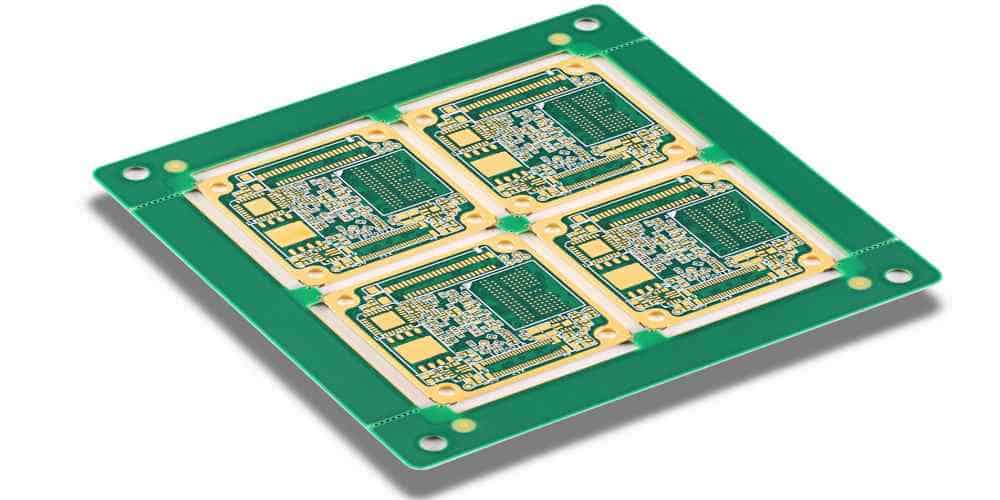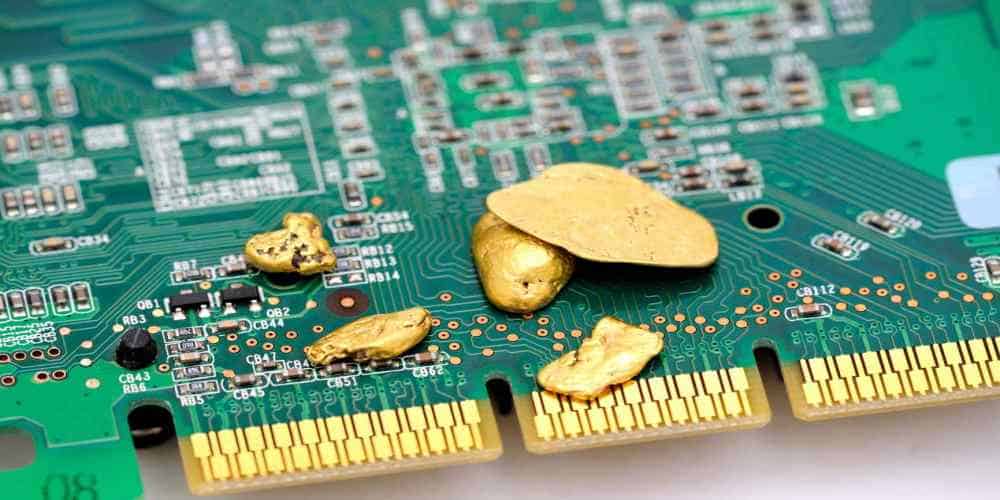A gold-plated circuit board is a form of PCB manufacturing that has gold plating on it. PCB gold plating is a prevalent procedure in today’s electrical industry. Because of the type of environment in which it will be used, some applications necessitate the use of this PCB. The plating of PCBs with gold is a common practice in the PCB industry. Gold-plated PCBs have become increasingly popular over time. In this article, we’ll cover all the bases when it comes to understanding gold-plated PCBs.

What is a Hard Gold?
When working on a project that needs gold plating, two design possibilities are available: hard gold plating and ENIG plating. The hard gold plating method produces a refined grain surface and harder deposits as a result of gold alloying with another element, such as iron, nickel, or cobalt. ENIG plating is significantly closer to pure gold. Since no extra elements are employed in the alloy, making ENIG coating is softer than hard plating. It is also known as “electroless nickel immersion gold” plating,
Important Hard Gold Finish Characteristics
Consider the following key factors when choosing a hard gold finish:
· Considerations for Bonding
Due to the existence of non-noble metals like nickel, cobalt, and others, soldering hard gold deposits is difficult. At soldering temperatures, these metals oxidize and weaken the solder joint. As a result, this finish is unsuitable for any kind of joining technique.
For applications such as ultrasonic wire bonding, thermosonic bonding, and so forth, ENIG is useful. Gold’s thickness and purity are perfect for these operations.
· Appearance
Because of its precise grain structure, hard gold plating has a dazzling look. As a result, it is a suitable solution for applications requiring visually acceptable gold contacts, such as visible interconnect applications.
· Corrosion Protection
Due to the addition of non-noble elements, the gold finish reduces the coating’s corrosion resistance. Furthermore, hard gold can be quickly oxidized at high temperatures.
· Resistance To Wear
Metallic components such as nickel, iron, and cobalt make up this finish. Deposits create finer grain structures that are more glossy and resist sliding wear as a result of these components.
These are some considerations to consider when deciding on a surface finish.
Process of PCB Hard Gold Plating
In the PCB sector, plating is classified into two types: electroless plating and electrolytic plating.
- Electroless Tinning
By depositing a metal atom on the surface of a substrate a metal plating layer is also formed. Electroless plating in an aqueous solution. It does not need an external source of electricity. For this plating process, an external current is not required. The electroless plating layer has a consistent thickness.
- Electroplating
This method includes placing a dense alloy or metal on the surface of the PCB. An external current can be the main element to coat the metal in this technique. During this process, the anode undergoes an oxidation reaction, which discharges the electrons and converts the metal atoms to cations.
Surface Finishes on PCB Gold

- Nickel Gold Electroplating (ENG)
Since the introduction of the PCB, electroplated nickel/gold has existed. This surface finish applies a coating of nickel to the surface conductor of the circuit board. After that, a layer of gold is put on the surface. After disposing of the nickel liquid separately, gold is put into the chemical syrup. The pre-processed PCB is then put into the electroplating cylinder by the manufacturer.
In the electrical sector, this PCB gold plating is popular. This is because gold is resistant to oxidation and wear.
- Immersion Gold/Electroless Nickel (ENIG)
This surface treatment bonds gold and nickel to the copper surface. This procedure does not make use of sophisticated power supply components. Activation, pickling, cleaning, microetching, electroless, and nickel plating are all common steps in the ENIG process. The plating of auto-catalytic nickel on the copper pad is the most important step here. To do this, it is necessary to use variables like pH, temperature, and additive concentration.
The nickel acts as a barrier to the copper. It also acts as the surface for PCB makers to solder components on. The gold protects the nickel while also providing minimal contact resistance. In the PCB industry, ENIG is the most widespread finish.
· Gold Fingers
Gold fingers have many uses. Some gold contacts are perfect for connecting the edge card. A gold finger is a gold-plated PCB connection. The gold fingers have a gold-plated termination. This surface finish makes it possible for data and power to move freely through a PCB. Gold fingers are purpose-built for edge contacts. They can withstand normal wear and tear.
Uses of Hard Gold
In certain situations, hard gold PCBs are perfect. Most smart industrial machines have this kind of circuit board. Robots for games, artificial intelligence, and education might feature them. Many electronic devices also use this kind of PCB. You can find this kind of PCB in cell phones, laptops, and other devices. It is conceivable to use a hard gold PCB to keep the electrical connection stable. This makes it a good option for a variety of applications.
1. Computer Systems
Gold-plated circuit boards are common in computer systems. Both laptop and desktop computers have these boards. Signal integrity and data transmission are critical components of computer systems.
2. Communication Systems
Telecommunications systems can use hard gold-printed circuit boards. You can find these circuit boards in GPS systems, satellite systems, and cell phones.
3. Systems for Manufacturing
Automated machines might have hard gold-plated circuit boards. This board is appropriate for this application since it is corrosion and wear resistant.
4. Electronics for the Home
PCBs made of hard gold does not corrode or rust. Gold has excellent conducting characteristics, allowing it to tolerate high temperatures. Consumer electronics like cell phones, TVs, and smartwatches use hard gold PCBs.
Difference between Hard Gold PCB and Soft Gold PCB

There are several acquaintances that are unsure about the “hard gold” and “soft gold” on the circuit board. People still think that you need hard gold for electroplating and soft gold for chemical gold. For this reason, let’s learn about the difference.
Hard gold electroplating is actually an alloy of gold and other metals. Because of this, it is hard and good for places where force and friction is needed. Soft gold electroplating is an electroplating alloy (i.e., gold and other metals), so it is soft and suitable for places requiring force friction. In the electrical industry, it serves as the plate edge contact point. Recent years have seen a rise in the use of soft gold for the front and back of BGA carriers, a material often reserved for aluminium wire on the cob (chip on board) or the touch surface of mobile phone keys.
To comprehend the origins of hard and soft gold, it is necessary to first comprehend the gold plating process. To get “gold,” we electroplate copper on the circuit board, but because “gold” reacts badly with copper, we must first electroplate a layer of “nickel” and then place the gold plating on top of nickel, thus although we call it “electroplating,” the correct word is “gold plating nickel.”
The difference between soft gold and hard gold is that in hard gold the composition of the gold coating is eventually glided. Because the hardness of pure gold is so soft, it is referred to as “soft gold” when plating gold. Cob will need the thickness of this pure gold layer for the manufacturing of aluminum wire since gold and aluminum may make an excellent alloy. Hard gold is any gold alloy that contains another metal, such as nickel, or a combination of gold and cobalt, and is therefore more durable than pure gold.
Soft and hard gold plating procedures:
- Pickling, nickel plating, and pure gold are all examples of soft gold.
- Pickling, nickel plating, pre-plating, nickel plating, or cobalt alloy for hard gold.
The majority of today’s alloys are known as electroless nickel plating gold, which has the benefit of attaching nickel and gold to copper without plating and having a smoother surface than plating, which is especially useful for lowering the flatness of electronic devices and components.
Appearance Hard Gold Plating and Soft Gold Plating
· Finish
Hard gold plating has a glossier or “brighter” finish than soft gold plating due to its smaller and more polished grain structure. Moreover, soft gold plating is more prone to scratches and damage due to burnishing or contact with other surfaces. Soft gold plating has a maximum hardness of 90 HK25, which is comparable to the hardness of a human fingernail. Hard gold plating is also used in those applications that require appealing visuals, these include visible interconnect applications.
· Functionality
In addition to selecting the appropriate gold plating, the underplate should be taken into account. Unbrightened sulfamate nickel plating is functionally better for bonding and soldering applications, as previously stated. However, this unbrightened nickel deposit sometimes results in a less aesthetically attractive matte gold appearance. It is important to note that although brilliant gold deposits are more visually appealing, they are not always operationally better, particularly in bonding or flexing applications where a more ductile nickel underplate, such as sulfamate nickel or soft gold, provides greater bonding and ductility.
Conclusion
As we can see, gold is present in the majority of modern gadgets. Gold is a valuable precious metal with exceptional qualities. In the electronic industry, these Gold plated circuit boards play an important role. These boards are suitable for a wide range of applications. There are two types of gold plating processes: immersion plating and electroplating. The two primary types of gold plating are soft gold plating and hard gold plating. This post has provided important information on hard gold plating PCB.

